Opinion
By Jeff Childers

11/8/25
Good morning, C&C, it’s Saturday! Welcome to the Weekend Edition. Today’s roundup features three legal stories: the ongoing food stamps dispute reaches the High Court; the SCOTUS saga of Trump’s tariffs, this week’s oral arguments, and the mysterious connection to another top-of-mind debate; and the Supremes return sanity to the creeping madness of gender identified passports.
🌍 WORLD NEWS AND COMMENTARY 🌍
⚖️⚖️⚖️
President Trump scored another major political win from the nation’s highest court yesterday, in the miniaturized form of a temporary stay order. The Beeb ran the schizophrenic story, headlined “Supreme Court says US food stamp funding can be temporarily halted.”

I called the reporting ‘schizophrenic’ because it was torn between narratives, unable to pick a lane, thereby running across the median, wiping out a hapless UBER Eats delivery moped, two parked meter maid scooters, and a Rastafarian food truck.
What I mean is, the SCOTUS’s order was just an emergency temporary stay. That is the shortest kind of temporary injunction (here, only two days), the easiest kind to obtain, and it decides nothing about the case’s merits. So, corporate media became conflicted and indecisive; if it reports that the stay wasn’t a major political win for Trump, how can it also brush it off as a brief, temporary setback?
Here’s what actually happened. Last week, the Democrats filed 24+ lawsuits to force the Trump Administration to fund SNAP after the normal budget was exhausted on October 31st. They got one judge to bite: Rhode Island District Judge John McConnell. (His TDS is starting to show, but more on that in a minute.)

Last Friday (a week ago), Judge McConnell gave the government two options. They could do it the easy way, by paying 100% of SNAP by last Monday, using emergency funds taken partly from the SNAP backup account, and the rest from the school lunch program. Or —the hard way— they could pay out just the SNAP emergency money on Wednesday, using some kind of partial-payment formula (he allowed two extra days since lawyers said SNAP computers don’t currently cope with partial payments).
On Wednesday, the government told Judge McConnell that it had complied. It sent out the money and a set of “tables” to the states. The tables showed that each SNAPper would get 65% of whatever they usually get— as much as the budget allowed. But the states —which have the job of paying the money to their individual recipients— said it would take weeks or months to adapt their systems to accommodate partial payments.
This unhappy news caused the already overheated engine of Judge McConnell’s mind to throw a piston. He was enraged. He blamed President Trump, who the judge clearly conceives of as a Snidely Whiplash character pulling the strings from the Oval Office and frustrating the judge’s heroic efforts to single-handedly stop 42 million hapless Americans from getting run over by the oncoming train of starvation.
Judge McConnell made that very point in a wild, 28-page order he furiously dashed off on Thursday. “The Defendants,” he began, warming to his theme, “overlook the fundamental point that compliance is achieved when Americans are fed, not when the federal government shifts the administrative burden of disbursing funds onto the States—especially when there is still no clear disbursement date in sight.”
Thus, Judge McConnell conditioned his order on the actions of third parties —the states— which are beyond the federal government’s control. He was in a box, and he knew it. So, since partial payments are impractical, he ordered the USDA to back up to his first option, and pay the entire November SNAP budget, using money allocated for school lunch programs to make up the difference.
In other words, in classic grade-school bully fashion, like a too-big kid held back for three years, Judge McConnell shook down some poor third graders for their lunch money. (He repeatedly noted that they can afford it, since the lunch program budget has $23 billion tucked away, and he only needs around $5 billion to shore up SNAP.)
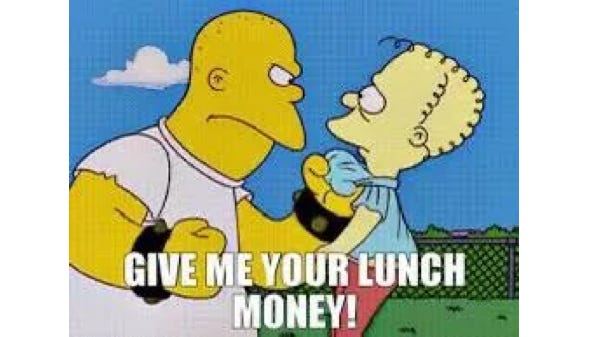
To say this kind of free-for-all budget-swapping between programs is legally dubious would be an understatement.
The Judge could have written a very short order: “The States cannot process the partial payments fast enough to provide relief, so the Court orders the federal government to pay the whole thing.” But McConnell raged for 28 pages, quoting various of President Trump’s Truth Social posts at least six times— three times in full. To the extent these out-of-court statements had any point, McConnell seems to suspect they prove President Trump was lying about something. He was too chicken to say what.
Further complicating things, nine states (including California) —the ones with up-to-date computers that are not still running Windows 95— had already transferred the partial payments according to the USDA’s tables. Eight other states and DC used their own money to make up the shortfall, and paid 100% anyway. Other states boosted payments to food-bank NGOs, which are gleefully reaping the benefits.
The Judge’s 28-page order took none of this complexity into account.
So on Friday, the Administration filed two hasty appeals: one to the First Circuit, and an emergency appeal to SCOTUS. Judge Jackson (which should tell you something) immediately entered the brief stay order, providing the First Circuit two days to consider whether to grant a longer stay, and “urged them” to hurry.
Bottom line: the USDA does not have to comply with Judge McConnell’s directive. Not yet. And every single day that goes by is a political win for President Trump in the government shutdown battle.
⚖️ Here’s what the difficult legal landscape the First Circuit is looking at: the government has already paid out the full emergency fund. That is done. Many states have already paid out some or all SNAP benefits, and others are taking steps to ensure that truly hungry people can find food. This makes it hard to pin down exactly what the “irreparable harm” might be.
And while I’m only guessing, I have trouble imagining the First Circuit authorizing the government to steal school lunch money to fund SNAP. It might set an awkward precedent; if they did, then what stops Trump from turning around and using the same school lunch budget to pay for other stuff, like military salaries or better judges?
Judge McConnell may have just run out of runway. He can fly his plane of rage all he wants, but he can’t land it, and it is running out of EBT credits. Trump is about to win the SNAP war. And— thanks again, SCOTUS!
⚖️⚖️⚖️
Several anxious readers, alarmed by liberal glee over this week’s oral arguments, and by President Trump’s relentless social media posts warning a bad decision would be “devastating for our country,” asked me to report on latest developments in the high-stakes tariff story. In short, never panic until I give the signal. Of the many corporate media stories, I selected yesterday’s entry from CNN, headlined, “What happens if the Supreme Court strikes down Trump’s tariffs? More tariffs.
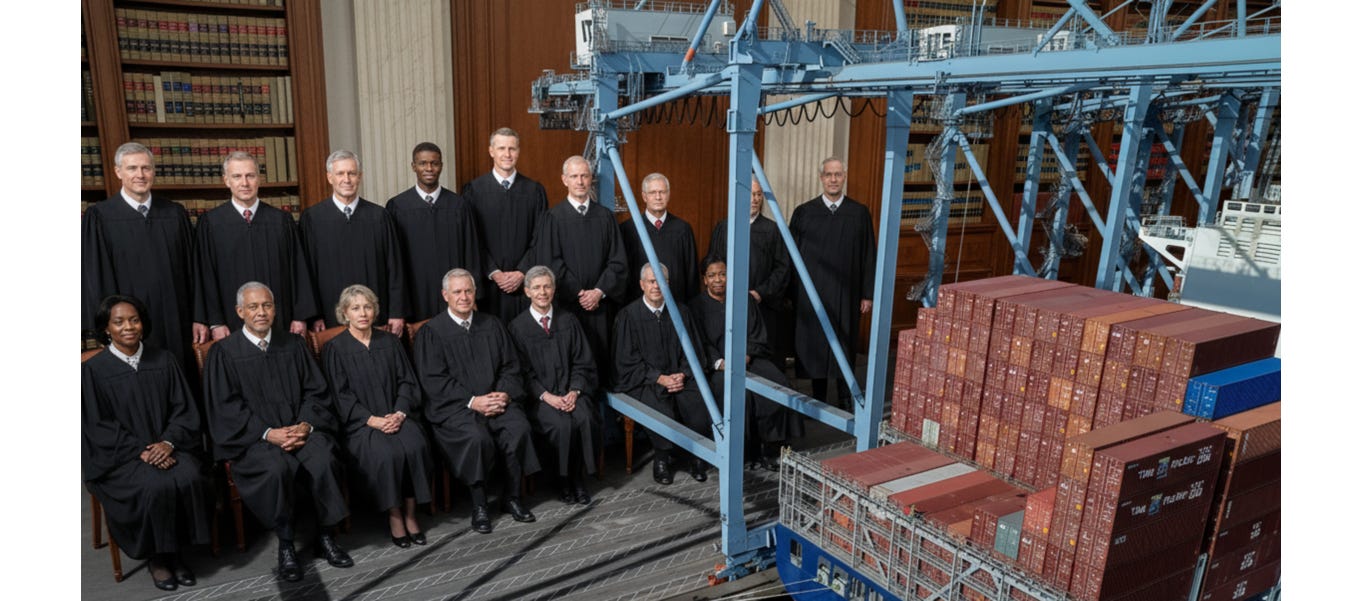
First, a little background. As regular readers know, President Trump has built a Tariff Dashboard decorated with lots of tiny dials, one for each country on Planet Earth, each of which he delightedly cranks up and down, dialing pain or pleasure, accomplishing more with economic leverage than a hundred kinetic wars could hope to do. In less than six months, Trump’s tariffs have helped close our borders, reduce dangerous illegal drugs, close favorable trade deals, reshore over a trillion dollars in new manufacturing, and raise close to a trillion more in cash from the tariffs themselves.
In and of itself, Trump’s tariff policy is an unparalleled historic achievement.
But there is one ugly fly in the tariff ointment. The Constitution expressly grants Congress —not the President— the power to “Levy Tariffs.” Thus, Democrats have built a legal circus out of those two words, because to them, stopping Trump from advancing American interests is worth any conceivable price.
On Wednesday, SCOTUS held oral arguments on the case. The stakes could not be higher. If Trump loses, much of what he has carefully built will collapse immediately. Foreign leaders will no longer fear him. Trade deals that haven’t yet been signed will dissolve into powder. Agreements to invest in American plants will become meaningless. We might have to refund the hundreds of billions collected from tariffs so far.
The questions and answers lit off a New Year’s worth of pundit fireworks, as everyone tried to predict which way the judges might go, based solely on the questions they asked the lawyers.
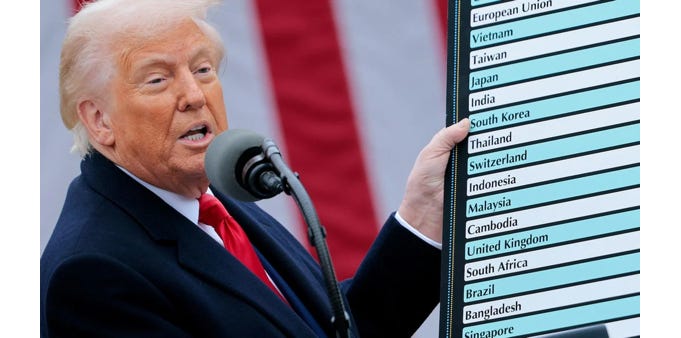
⚖️ Congress has constitutional tariff authority, but Congress is also lazy and cowardly. Over the decades, Congress has delegated its tariff powers to presidents through a complex array of laws. The broadest and easiest one —the one Trump has thus far relied on— is labeled the International Emergency Economic Powers Act (IEEPA, which I pronounce “Jeepers!”).
In another bizarre twist, IEEPA doesn’t actually even say the President can impose tariffs. It only says that, under a declared emergency, the president can “investigate, block, …regulate, direct and compel, nullify, void, prevent or prohibit, any … importation.” During Wednesday’s oral arguments, the justices invoked the verb “regulate” 155 times. That’s the only one that possibly fits.
In short: does “regulating importation” include tariffs? Unhelpfully, IEEPA’s authorization to “regulate” includes some details. It provides that he can regulate imports “by means of instructions, licenses, or otherwise.” Not too helpful. It only shifts the question to: what does “or otherwise” mean?
Are tariffs included in “otherwise?” Does “otherwise” include nukes? Nancy Pelosi on a circus pony?
Thus, the torturous debate over one generic verb (regulate), and one open-ended noun (otherwise), plunges the nation into a rhetorical sinkhole of appellate witchcraft, in the form of a series of elaborate, Harry Potter-esque Latin invocations like noscitur a sociis, ejusdem generis, and expelliarmus!
(Reader bonus question: Is it ‘regulating’ when a random husband says he’s tired of Mexican food but the rest of the family wants to eat out at La Fiesta for the third straight time? Discuss in the comments.)

⚖️ To be fair, there is another impressive issue related to the Major Questions doctrine, which SCOTUS wielded like a Samurai sword during Biden’s pandemic reign of terror. The doctrine says that Congress may not broadly delegate its constitutional powers to the Executive Branch without expressly and in great detail spelling out exactly what it is and isn’t delegated.
It’s kind of like telling your neighbor sure, they can borrow your lawnmower, but they think it also means they can use your garage whenever they want. Boundaries.
Anyway, since conservative justices love the Major Questions doctrine, and that doctrine undercuts Trump’s IEEPA interpretation, Democrats’ lawyers have giddily written reams of briefs taking the exact opposite position from just a couple of years ago while the Cabbage-in-Chief excitedly massaged his Autopen in the Oval Office.
Now, Democrats love Major Questions, too.
Finally, the liberal justices’ questions pointed out, correctly, that only Congress can raise money through taxation— yet President Trump won’t stop bragging about all the money tariffs are raising. In their view, if tariffs are taxes, intended to raise revenue, and not a legitimate national security tool, then the President can’t use them. (The conservative majority seemed less interested in this line of argument, but you never know.)
ScotusBlog’s careful analysis suggests the case will boil down to the textual interpretation, not Major Questions or taxes. But, based on how the oral arguments went, they still predict Trump will lose.
Hence, all the hair-pulling.
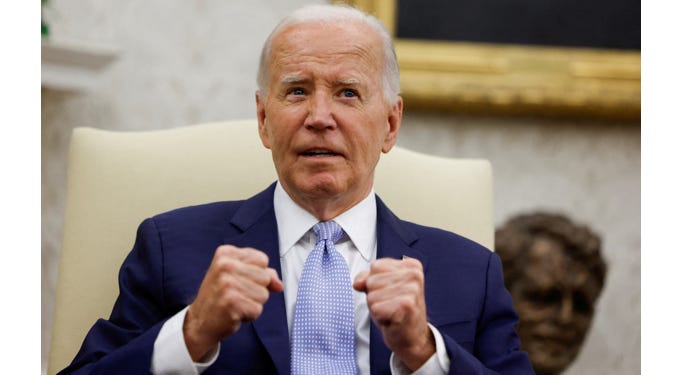
⚖️ I’ll make two observations cutting against ScotusBlog’s dour outlook.
First, everyone knows that handicapping oral arguments is extremely difficult, especially in high-profile cases. For instance, my firm is lead counsel directing a team of law firms prosecuting a case worth a quarter billion dollars. During oral arguments, the three-judge appellate panel asked our appellate lawyer zero questions, but peppered the hospital’s lawyer with one hard question after another, to which the hospital’s lawyer mostly mumbled and stuttered.
Then, defying all rational predictions from how well that hearing seemingly went, they still ruled against us. (Further appeals are underway.)
So you just never know.
Second, there was a more optimistic take, which seized on a third word, “embargo.” Justices Alito, Gorsuch, and Barrett all pressed the question of whether IEEPA’s grant of “embargo” authority logically also includes tariff powers. Why, they wondered, would Congress delegate the drastic option to halt all trade, but not include the milder option of taxing it? Otherwise, there would be a legal “odd donut hole” in the IEEPA powers if tariffs are excluded but embargoes are allowed.
As you can see, it’s a legal mess, and regardless of what any pundit says, the oral arguments did not provide much clarity either way. Now, let’s look at the politics.
⚖️ As mentioned, President Trump has clearly called an adverse ruling “disastrous.” It would be disastrous, if not catastrophic, if Trump loses his tariff powers. But options and intriguing hints swirl. Yesterday, excited reporters pressed him on what he would do if he loses the IEEPA case. Then “we’ll have to develop a game two plan,” Trump said.

We now return to CNN’s headline, “What happens if the Supreme Court strikes down Trump’s tariffs? More tariffs.” Most financial analysts, unlike the political partisans, predict that Trump will find a workaround.
“We would expect the administration to use other authorities to impose substantially similar tariffs,” Goldman Sachs economists said in an investor note earlier this week. “Large trading partners would likely see little change,” they added blandly.
CNN then listed off several other statutes besides IEEPA that also delegate tariff powers to the President (though each offers pros and cons): Sections 122 and 301 of the 1974 Trade Act, Section 232 of the 1962 Trade Expansion Act, and, going all the way back, Section 338 of the Tariff Act of 1930.
But there’s another, bigger, more explosive option. Call it the nuclear option. We have one more dot to connect.
⚖️ Late last week, Trump started posting a lot about two things: the tariff case and ending the filibuster. Since I wrote it up in yesterday’s roundup, Trump has pressed the Senators even harder on filibuster reform. This morning, while I was writing, Trump posted this:

Here is what I think: Trump’s recent push to end the filibuster is not about getting the federal government funded. It’s part of his “Plan B” for tariffs. If the Supreme Court deletes his IEEPA tool, which seems possible (if not likely), I think what Trump really wants is for Congress to pass a law explicitly authorizing his Tariff Dashboard.
The only way that can happen is if the silent filibuster rule ends first. So Trump isn’t waiting around for SCOTUS to decide.
I hate to put it this way, but Senators have a stark decision: we can beat globalism, but they must give up their useless and destructive silent filibuster rule, even though it was created based on the optimistic ideal of bipartisanship —a fanciful notion to which some Senators still unironically cling.
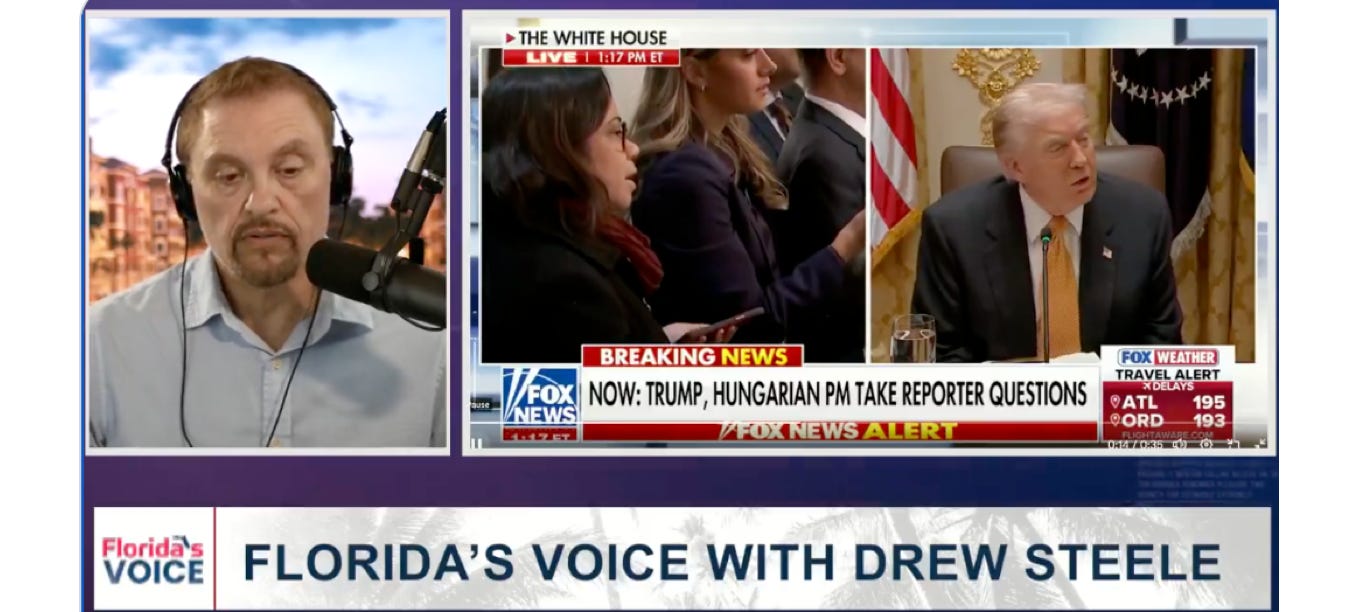
CLIP: President Trump says the bipartisan filibuster ‘didn’t work’ (0:52).
There’s another reason Republican Senators (and also Democrats) want to keep the filibuster. It gives them cover for clandestinely opposing a presidential priority. They can safely support a bill the President wants, but which they don’t. He’ll never know of their lack of real support, because GOP Senators can just blame their inaction on a filibuster fail. Sorry, we tried.
The filibuster was never meant to be a minority veto. As the clip above explained, it was originally designed to slow down debate. Not stop debate. The current silent filibuster rule is, in fact, a malignant mutation that stops debate in its tracks and acts as a minority veto. None of that is constitutional.
To be completely fair, President Trump has never, not one time, linked tariffs to the filibuster. I find that omission fascinating. He’s offered virtually every other priority, going so far as to make a two-page list:

CLIP: Trump unveils list of post-filibuster priorities (1:02).
Reading from the list, the President said yesterday, “Here’s some of the things we’d pass if we terminated the filibuster: Voter ID, No Mail-In Voting, No Cash Bail, No Men in Women’s Sports, No Welfare for Illegals. You can go on and on.”
Why not include tariffs on the priority list? I’ll propose two possibilities. First, strategically, Trump wants to avoid undermining his current tariff position. In other words, why would he even need a new law, if the current tariff laws are legally sufficient? Second, he doesn’t want to give the Democrats any advance notice it is coming.
My bet would be that, if the Senate gets its act together and ends the silent filibuster, the very first bill would pass the continuing resolution and re-open the government. But as soon as the Supreme Court goes sideways on IEEPA, the very next bill would ratify the President’s tariff dashboard.
Instead of calling for useless votes to pass the clean continuing resolution —15 so far— they should be calling votes to end the filibuster.
Honestly, this whole thing is more entertaining to watch than House of Cards multiplied by Avengers: Endgame. Remember— TAW.
⚖️⚖️⚖️
Rounding out the trifecta of today’s legal topics, we discover another Trump victory in the High Court. This morning, Slate covered the story below the dramatic headline, “The Supreme Court’s Anti-Trans Passport Decision Is Both Mystifying and Malicious.”

The U.S. federal government has allowed transgender passports to reflect people’s non-biological sex for, if you can believe it, 33 years. (I know; there’s that number again.) In 1992, President George H.W. Bush’s State Department quietly changed the rule, allowing surgical transsexuals to mark their passports with their “selected” gender. I could find no record of any congressional discussion about it at the time. Weird.
In 2010, Obama’s State Department deleted the surgical requirement, replacing it with a doctor’s note about any clinical treatment (i.e., hormone replacement). In 2021, Joe Biden went further, soaring beyond the patriarchal limitations of “M” and “W,” and creating a whole new passport gender category of “X”— for gender-neutral, non-conforming, and non-binary, whatever that means.
Presumably, the next Democrat president would’ve added even more letters. Things were obviously getting out of hand.
This year, President Trump issued an executive order reversing the State Department rules, and requiring all newly issued passports to show a person’s biological sex. Period. Lawsuits and injunctions ensued.
The lower court, and then the Court of Appeals, sided with transgender people. They enjoined the revised rule as illegally discriminatory, abusive, and worst of all, transphobic.
But on Thursday, the Supreme Court temporarily approved the Trump rule (6-3), lifting the stay, while lower courts continue to consider the case. In its unsigned emergency order, SCOTUS made three findings:
- The Trump policy requiring passports to list “biological sex at birth” does not violate equal protection principles, any more than listing country of origin; the government is just “attesting to a historical fact.”
- The challengers had “failed to establish” that the policy “lacks any purpose other than a bare … desire to harm a politically unpopular group.”
- Most significantly, the order explicitly said the administration is likely to succeed on the merits. This is the legal standard for letting the rule take effect pending further litigation, and it sends a strong signal to the lower courts.
In The Times’ story (neatly tucked away in the Travel section), the Times naively wondered how the government could possibly verify a person’s biological sex. (“The State Department has not said how it will verify if a person’s birth sex matches the sex listed on their passport,” it sneered, suggesting they’ll have to come out and take a look beneath the skirts for themselves.) They did not mention that the penalty for knowingly lying on a U.S. passport application (18 U.S.C. § 1542) is up to 10 years in federal prison plus a fine of up to $250,000.
Trump wins again.
Have a wonderful weekend! Bring your gender-accurate passports back with you on Monday morning, as we kick off another terrific week of C&C essential news and commentary.
Don’t race off! We cannot do it alone. Consider joining up with C&C to help move the nation’s needle and change minds. I could sure use your help getting the truth out and spreading optimism and hope, if you can: ☕ Learn How to Get Involved 🦠
Twitter: jchilders98.
Truth Social: jchilders98.
MeWe: mewe.com/i/coffee_and_covid.
Telegram: t.me/coffeecovidnews
C&C Swag! www.shopcoffeeandcovid.com
The views expressed in this commentary are those of the author and do not necessarily reflect the official position of Citizens Journal Florida









